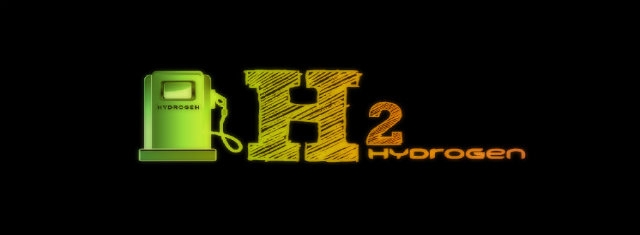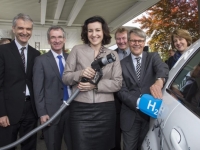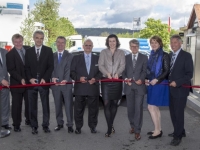Automobiles
Germanys first hydrogen filling station on the autobahn opens
hydrogen Mobility

h2 (Source: Daren Frankish)
USPA NEWS -
Germany's first hydrogen filling station on the autobahn opens.
Daimler, Linde and TOTAL create southern Germany´s first hub for hydrogen mobility. Other stations planned by end of 2015. Funded by the National Innovation Programme (NIP).
Daimler, Linde and TOTAL create southern Germany´s first hub for hydrogen mobility. Other stations planned by end of 2015. Funded by the National Innovation Programme (NIP).
As part of the Clean Energy Partnership (CEP), Daimler, Linde and TOTAL have jointly taken an important step forward in the expansion of Germany´s hydrogen (H2) infrastructure. In the presence of Dorothee Bär, Parliamentary State Secretary at the Federal Ministry of Transport and Digital Infrastructure, Germany's first motorway hydrogen filling station was officially inaugurated today. The new H2 filling pump at the TOTAL motorway service area in Geiselwind on the A3 between Würzburg and Nuremberg links the existing filling facilities in the metropolitan regions of Frankfurt/Main, Stuttgart and Munich with each other, forming a hub for electric fuel cell vehicles in southern Germany.
In her opening speech, State Secretary Bär said: “Electric vehicles with hydrogen fuel cell drives produce no harmful emissions. They have a long range and can refuel in minutes. Politics, science and industry have worked together to bring hydrogen mobility to the brink of market entry. Together with industry, we have provided a total of 1.4 billion euros for research, development and demonstration projects up until 2016.
We are now increasingly tackling the development of infrastructure: by the end of 2015, 50 hydrogen filling stations will be available in metropolitan areas and along major roads. The new filling station in Geiselwind brings us one step closer to this target. The nearly one million euros of funding spent on the construction of this filling station is money well spent because good infrastructure is a prerequisite for this new form of mobility to really catch on!“
“Networking the national H2 infrastructure is the key to success for the market introduction of electric vehicles with fuel cells. Only then can they be a “˜real´ alternative for customers,“ says Prof. Dr Herbert Kohler, Vice President Group Research and Sustainability and Chief Environmental Officer at Daimler AG. “That's why we are not only actively investing in the development of the next generation of vehicles, but we are the only car manufacturer to invest in the development of a nationwide network of filling stations in Germany.“
“Thanks to the long range of fuel cell vehicles and this ideally positioned motorway location, we are now one step closer to nationwide coverage,“ said Markus Bachmeier, Head of Hydrogen Solutions at Linde. “We are therefore especially pleased to have contributed to this important milestone with our refuelling technology and our sustainably produced hydrogen.“
Guillaume Larroque, Director of Service Stations at TOTAL Germany, emphasised: “We see ourselves as trailblazers in building the hydrogen filling station infrastructure in Germany. We have demonstrated this with our commitment for over twelve years. Including Geiselwind, TOTAL already operates seven of the 18 public H2 filling stations in Germany ““ at TOTAL alone, well over 1,000 fuel cell vehicles could already be refuelled with green hydrogen today.“
At the inauguration, Alexander Ruscheinsky, Chairman of the Vereinigung Deutscher Autohöfe e.V. (German Association of Motorway Service Areas ““ VEDA), said: “The operators of motorway service area are committed to the development of new forms of mobility, and have already opened up their facilities for various electric charging concepts. So it is only logical that the first autobahn hydrogen filling station is at a service area. After all, the fact that they serve both directions of a motorway and intersecting A and B roads makes them an inexpensive way to efficiently develop a new refuelling network.“
TOTAL has invested more than 250,000 euros in Geiselwind and shouldered all construction and approval costs, as well as the project management for installing the hydrogen technology, including service and maintenance components.
With around 90 stations set up in 15 countries, Linde has for many years been a leader in hydrogen technology. It operates the world's first small-series production facility for hydrogen fuelling stations in Vienna, where Linde uses its proprietary IC90 ionic compressor, which combines advantages in power consumption, maintenance and noise.
With around 90 stations set up in 15 countries, Linde has for many years been a leader in hydrogen technology. It operates the world's first small-series production facility for hydrogen fuelling stations in Vienna, where Linde uses its proprietary IC90 ionic compressor, which combines advantages in power consumption, maintenance and noise.
The construction of a nationwide hydrogen infrastructure in Germany is accompanied by the planned market ramp-up of fuel cell cars from various manufacturers. The Geiselwind site is part of the expansion plan launched in 2012 that will initially expand the German H2 network from its current 18 locations to 50. With 50 hydrogen filling stations, nationwide mobility between metropolitan areas along the main roads will be possible throughout Germany. Within this expansion programme, the Daimler-Linde initiative is participating in a total of 20 new H2 stations with a total investment of approximately 20 million euros.
The project is supported by the Federal Ministry of Transport and Digital Infrastructure as part of its National Innovation Programme for Hydrogen and Fuel Cell Technology (NIP). The programme is managed by NOW GmbH (National Organisation for Hydrogen and Fuel Cell Technology).
Source: Daren Frankish Media | Daimler AG. Geiselwind/Berlin/Munich/Stuttgart, May 04, 2015
Source: Daren Frankish Media | Daimler AG. Geiselwind/Berlin/Munich/Stuttgart, May 04, 2015
more information: https:////cleanenergypartnership.de/home/
Liability for this article lies with the author, who also holds the copyright. Editorial content from USPA may be quoted on other websites as long as the quote comprises no more than 5% of the entire text, is marked as such and the source is named (via hyperlink).








